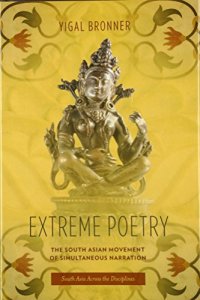
Ebook: Extreme Poetry: The South Asian Movement of Simultaneous Narration
Author: Yigal Bronner Michael Bronner
- Tags: Puns & Wordplay, Humor, Humor & Entertainment, Indian, Asian, Regional & Cultural, History & Criticism, Literature & Fiction, Ancient & Classical, Ancient Classical & Medieval, Poetry, Literature & Fiction, Asian, Chinese, Japanese & Haiku, Regional & Cultural, Poetry, Literature & Fiction, Inspirational & Religious, Themes & Styles, Poetry, Literature & Fiction, Hinduism, Chakras, Gandhi, History, Rituals & Practice, Sacred Writings, Sutras, Theology, Religion & Spirituality
- Series: South Asia Across the Disciplines
- Year: 2010
- Publisher: Columbia University Press
- Edition: 0
- Language: English
- epub
Beginning in the sixth century C.E. and continuing for more than a thousand years, an extraordinary poetic practice was the trademark of a major literary movement in South Asia. Authors invented a special language to depict both the apparent and hidden sides of disguised or dual characters, and then used it to narrate India's major epics, the Ramayana and the Mahabharata, simultaneously.
Originally produced in Sanskrit, these dual narratives eventually worked their way into regional languages, especially Telugu and Tamil, and other artistic media, such as sculpture. Scholars have long dismissed simultaneous narration as a mere curiosity, if not a sign of cultural decline in medieval India. Yet Yigal Bronner's Extreme Poetry effectively negates this position, proving that, far from being a meaningless pastime, this intricate, "bitextual" technique both transcended and reinvented Sanskrit literary expression.
The poems of simultaneous narration teased and estranged existing convention and showcased the interrelations between the tradition's foundational texts. By focusing on these achievements and their reverberations through time, Bronner rewrites the history of Sanskrit literature and its aesthetic goals. He also expands on contemporary theories of intertextuality, which have been largely confined to Western texts and practices.
Originally produced in Sanskrit, these dual narratives eventually worked their way into regional languages, especially Telugu and Tamil, and other artistic media, such as sculpture. Scholars have long dismissed simultaneous narration as a mere curiosity, if not a sign of cultural decline in medieval India. Yet Yigal Bronner's Extreme Poetry effectively negates this position, proving that, far from being a meaningless pastime, this intricate, "bitextual" technique both transcended and reinvented Sanskrit literary expression.
The poems of simultaneous narration teased and estranged existing convention and showcased the interrelations between the tradition's foundational texts. By focusing on these achievements and their reverberations through time, Bronner rewrites the history of Sanskrit literature and its aesthetic goals. He also expands on contemporary theories of intertextuality, which have been largely confined to Western texts and practices.
Download the book Extreme Poetry: The South Asian Movement of Simultaneous Narration for free or read online
Continue reading on any device:

Last viewed books
Related books
{related-news}
Comments (0)